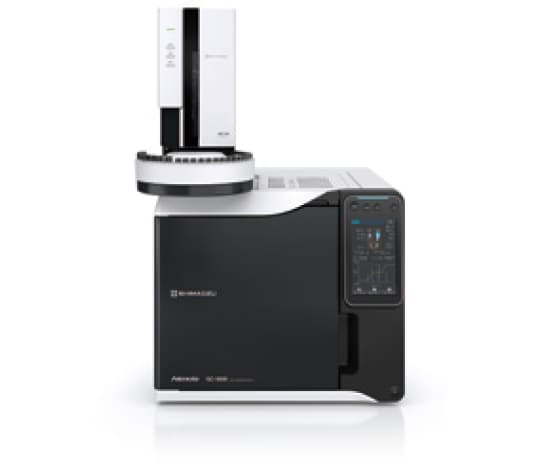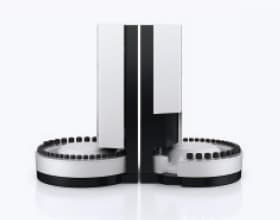Proposed Initiatives for Conserving Electricity
Gas Chromatography
- Measures and Proposals to Reduce Helium Gas Consumption
- Proposed Initiatives for Conserving Electricity
In gas chromatography, the oven is repeatedly heated and cooled, which uses a lot of electricity. In recent years, calls to conserve electricity due to stringent power demands, and soaring electricity prices have become commonplace, and methods of conserving electricity during everyday analysis work are urgently needed. Here, we introduce methods for conserving electricity that can easily be applied to routine analysis work.
-
Operational Approaches to Conserving Electricity
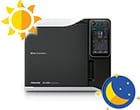
Here, we introduce two methods: automatically shutting down the instrument after analysis using the time scheduler function, and reducing the time that the instrument is idle using the remote control.
-
Instrument-Related Approaches to Conserving Electricity
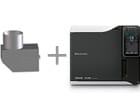
Here, we introduce optionally available equipment for lowering the heat capacity of the instrument and venting waste heat externally. In addition, we describe dual lines, which can analyze two samples at once
*Nexis GC-2030 only
Effects of Electricity Conservation Measures
Defining the power usage without taking any conservation measures as 100, the amounts of electricity conserved using the above-mentioned measures are graphed. Even more, electricity is conserved by combining multiple measures.

*The graph shows a comparison using the conditions below, for 20 samples a day, with a 30-minute analysis per sample. For the conditions in detail, refer to "Methods for Calculating the Electricity Conserved."
| Countermeasures to Conserve Electricity | Analysis Time (H) | Standby Time (H) | Sleep Time (H) | Electricity Conserved |
|---|---|---|---|---|
| No Conservation Measures |
10 | 14 | - | - |
| Schedule Setting | 10 | 4 | 10 | 44% |
| Schedule Setting Oven Insert |
10 | 4 | 10 | 47% |
| Schedule Setting Oven Insert Dual Line |
5 | 3 | 16 | 71% |
Electricity Conservation Method 1: Shutting down Instrument Control Efficiently with the Schedule Setting
With gas chromatographs, the temperatures of the sample injection port, detector, and column oven are held constant even during standby, so power is always consumed. To reduce this power consumption during standby, shutting down the instrument is recommended if it will not be used for a while such as overnight or on holidays.

Shimadzu gas chromatographs are equipped with functions that automatically shut down and start up control of the gas and the instrument temperature. Electricity conservation can be implemented easily using these functions. For example, even if the instrument is shut down automatically overnight, the startup is performed automatically the next day, so analysis can start smoothly. In addition, gas control is also shut down and started up automatically, which is an effective way of preventing helium gas supply shortages. Further, the Nexis GC-2030, our latest model, is equipped with a sleep mode function, which can completely shut down the instrument control.
Setting the Times for Automatic Shutdown and Startup of the Instrument Using the Automatic Shutdown and Automatic Startup Function
During the night, when there is no one in the laboratory, the instrument is shut down, and the next day, everything from instrument startup to supplying the gas, and stabilizing the oven temperature and detector is performed.

Note: During the automatic shutdown, the gas chromatograph power remains ON, but temperature and gas control is shut down. Communications with the PC are also maintained during the automatic shutdown.
Other Schedule Setting Examples
-
Configuring Which Days to Implement Automatic Shutdown and Automatic Startup
Settings can be configured separately by day, so it is recommended that the automatic shutdown and startup function be preset for Sundays and other fixed holidays. -
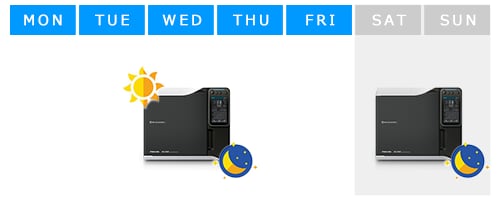
Electricity Conservation Method 2: Shutting down and Starting up the Gas Chromatograph by Remote Control
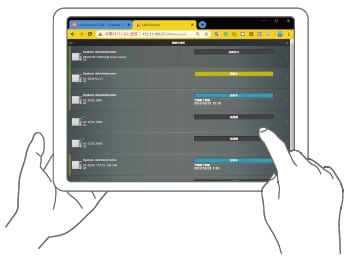
With LabSolutions Direct, the instrument can be controlled and monitored remotely with a smart device and a PC web browser, using the functions included as standard with LabSolutions LC/GC. Analysis can be performed while checking the instrument status, even at a distance from the laboratory.
The following methods are for heightening the efficiency of analysis work using these functions.
For example, if you plan to work from home the day after a consecutive analysis, you can check the data already acquired (instruments A and B in the figure below for example), and then shut down the instruments remotely if there are no issues with the results and no subsequent analysis is scheduled. Alternatively, you can contact someone working at the laboratory, and have the instruments used for the next analysis, thereby minimizing the instrument standby time.
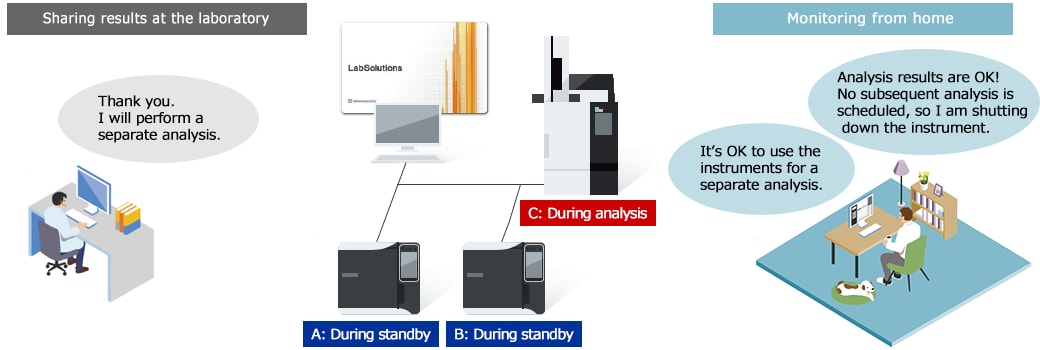
Electricity Conservation Method 3: Using an Oven Insert*
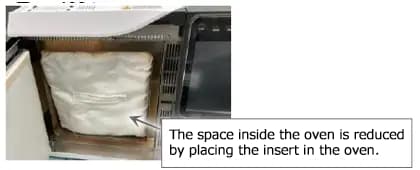
The oven, which controls the column temperature, consumes more electricity than any other part of a gas chromatograph. Power consumption can be reduced however by minimizing the space in the oven. The oven insert optionally available for the Nexis GC-2030 reduces the oven capacity, so the power consumption can be reduced by 5 to 10 % just by inserting this into the oven as shown in the photograph.
*Nexis GC-2030 only
Electricity Conservation Method 4: Venting High-Temperature Exhaust Gas from a Duct*
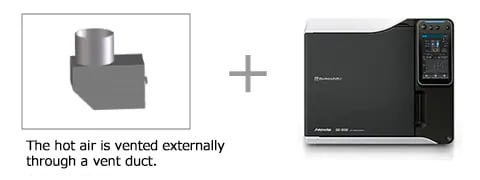
In gas chromatography, separation efficiency is increased by raising the column oven temperature. However, to return to the default temperature after the analysis is finished, the heated air inside the oven is vented externally. Passing the air vented at this point directly into a duct avoids venting it directly into the laboratory. This is an effective method for conserving electricity, particularly in summertime, a season in which the air conditioner is running on high, and is often used in Europe and other places outside Japan.
*Nexis GC-2030 only
Electricity Conservation Method 5: Using a Dual Line Configuration
In dual line analysis, two samples can be analyzed simultaneously in a single analysis heating cycle. This not only heightens analysis efficiency but also conserves a significant amount of electricity. The AOC-30 series of autosamplers, which is configured with a space-saving layout for dual analysis, can perform up to 30 consecutive analyses and can analyze up to 60 samples in 30 analysis heating cycles. This is recommended for those who must analyze large volume samples, and wish to reduce the analysis time and conserve electricity.
Methods for Calculating the Electricity Conserved
The effectiveness of the electricity conservation measures was evaluated based on test results with the GC operating conditions noted below. The effectiveness of the electricity conservation will differ with the GC conditions used.
GC
GC-2030
Injection Port and FID Detector: 350 °C
GC Oven: 40 °C → Heated at 15 °C/min → 320 °C and maintained for 10 minutes
Operating Conditions
| Title | Mon. to Fri. | Sat. and Sun. |
|---|---|---|
| Typical Operating Hours | 10:00 Start of analysis 20:00 End of analysis (Analysis of 20 samples) 20:00 Enters standby |
Standby |
| Operating with the Schedule Setting | 8:30 Automatic startup (Start gas control → Start temperature control) 10:00 Start of analysis 20:00 End of analysis (Analysis of 20 samples) 21:30 Automatic shutdown (Temperature control shutdown → Gas control shutdown) standby |
Standby |
| Operating with the Schedule Setting (Dual Line Analysis) | 8:30 Automatic startup (Start gas control → Start temperature control) 10:00 Start of analysis 15:00 End of analysis (Analysis of 20 samples) 16:30 Automatic shutdown (Temperature control shutdown → Gas control shutdown) standby |
Standby |
• The comparison of electricity conservation introduced on this page was calculated from an in-house evaluation. The numerical values will differ depending on the options built into the GC and the operating environment.
In addition, the GC-2014 and GC-2025 are not equipped with sleep mode, but they are equipped with an equivalent function that turns OFF GC temperature control. (This conserves less electricity than the GC-2030.)
• Refer to the instruction manual for how to configure automatic startup and standby (temperature control OFF for the GC-2014 and GC-2025) with the time scheduler.
• If the HS-10/HS-20 headspace sampler is used, electricity can be conserved by using the startup and shutdown function in the LabSolutions data analysis system. The startup and shutdown function is not compatible with the TD-30 thermal desorption system and other peripheral equipment.
ECO Simulation Calculates the Savings
This tool simulates the reduction in running costs, such as power consumption, and CO2 emissions using the new GC-MS system as compared to your current GC-MS system.



